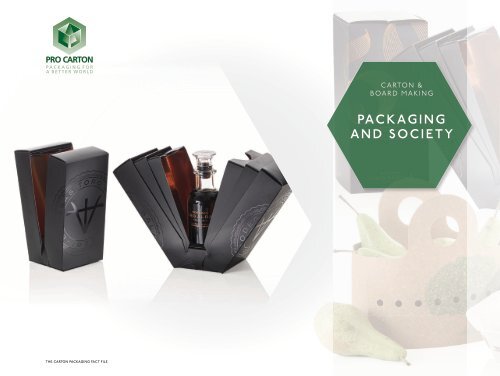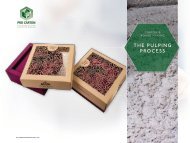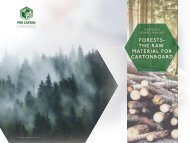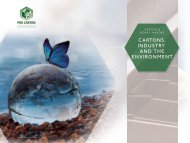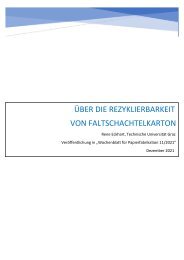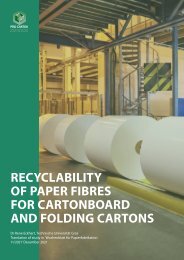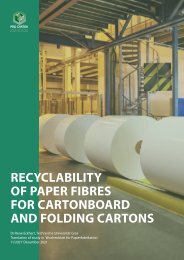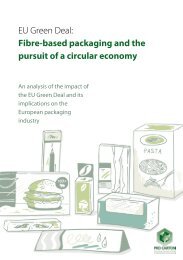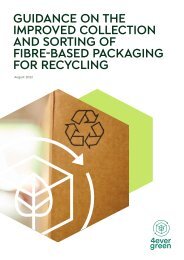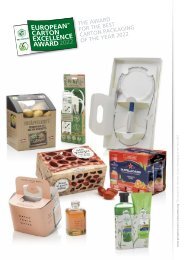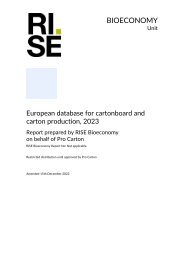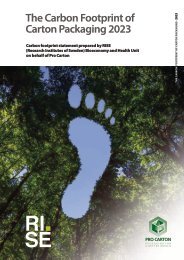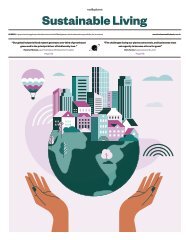Create successful ePaper yourself
Turn your PDF publications into a flip-book with our unique Google optimized e-Paper software.
CARTON &<br />
BOARD MAKING<br />
PACKAGING<br />
AND SOCIETY<br />
THE CARTON PACKAGING FACT FILE
CHOOSE FOLDING CARTONS<br />
CARTON &<br />
BOARD MAKING<br />
WHY DO WE NEED PACKAGING?<br />
<strong>Packaging</strong> is manufactured in many forms to protect the product throughout transportation <strong>and</strong> to display the product at<br />
point of sale. <strong>Carton</strong>s, glass <strong>and</strong> plastic bottles, sachets, wrappers, plastic <strong>and</strong> foil containers are all examples of packaging.<br />
The term 'packaging' also includes the materials that are used to minimise damage to products during transport, h<strong>and</strong>ling<br />
<strong>and</strong> distribution such as corrugated cases, shrink wrap <strong>and</strong> wooden pallets.<br />
<strong>Packaging</strong> helps to protect the quality of the product throughout its shelf life, especially perishable goods that are also<br />
supported by ‘sell by’ <strong>and</strong> ‘use by’ date coding on their packaging.<br />
PACKAGING<br />
AND SOCIETY<br />
WHAT ROLE DOES PACKAGING PLAY IN SOCIETY?<br />
<strong>Packaging</strong> is indispensable in modern society. It allows a multitude of goods to reach the consumer undamaged, in a safe<br />
<strong>and</strong> hygienic condition <strong>and</strong> also to communicate important br<strong>and</strong> <strong>and</strong> product information. <strong>Packaging</strong> helps to prolong<br />
shelf life of perishable products <strong>and</strong> contributes to reduce food waste.<br />
Without packaging it would simply not be possible for consumers to have access to, <strong>and</strong> use, most of the products, which<br />
are available today.<br />
IS PACKAGING WASTEFUL?<br />
No, packaging protects the product through distribution, display <strong>and</strong> onto the consumer. The truth is that packaging<br />
prevents waste <strong>and</strong> can help in extending product shelf life.<br />
The European carton <strong>and</strong> paper packaging industry is a leading recycler. The European rate for recycling cardboard <strong>and</strong><br />
paper packaging is over 84.2% (Eurostat 2018). We are reaching approximately 6.3 closed loops of recycling every year -<br />
Closed-loop recycling is the process by which a product or material can be used <strong>and</strong> then turned into a new product<br />
indefinitely without losing its properties during the recycling process. (Wikipedia).<br />
PACKAGING HELPS TO REDUCE FOOD WASTE<br />
Food waste or food loss means food that is not consumed. The causes of food waste or loss are numerous <strong>and</strong> occur<br />
throughout the food chain, during production, processing, distribution, retail <strong>and</strong> in the home.<br />
Globally, wasted food accounts for about 8% of all greenhouse gas emissions. About a third of all the world's food goes<br />
to waste, <strong>and</strong> producing, transporting <strong>and</strong> letting that food rot releases 8-10% of global greenhouse gases.<br />
Food packaging helps prevent waste <strong>and</strong> therefore helps reduce CO2 emissions. <strong>Packaging</strong> should be fit for<br />
purpose <strong>and</strong> provide adequate protection for the product. <strong>Pro</strong>duction of food generates 10-20 times more CO2 than the<br />
production of packaging material; using packaging to prolong the shelf life of valuable products actively contributes to a<br />
reduction of global greenhouse gases.<br />
THE CARTON PACKAGING FACT FILE<br />
All contents copyright © BPIF 2017.
CHOOSE FOLDING CARTONS<br />
CARTON &<br />
BOARD MAKING<br />
IS PACKAGING EXPENSIVE?<br />
The cost of packaging is only a small proportion of the price of a packed product. The golden rule is: <strong>Packaging</strong> should<br />
always save more than it costs.<br />
PACKAGING<br />
AND SOCIETY<br />
<strong>Carton</strong>s, in particular, contribute a very small percentage of the price paid by the consumer at the point of purchase -<br />
2-4% for most products <strong>and</strong> for some products, such as medicines, less than 0.1%.<br />
Depending on the value of the packed product, the costs of packaging adds typically a low single digit percentage to the<br />
cost of goods sold. The value of protecting the product <strong>and</strong> prolonging shelf life of the product exceeds the costs<br />
of packaging.<br />
The social costs of packaging also include the environmental impact of the packaging. <strong>Carton</strong>board is produced from<br />
renewable resources <strong>and</strong> is fully recyclable <strong>and</strong> biodegradable. Fibres can be recycled more than 25 times <strong>and</strong> will create<br />
the base for new packaging that is derived from recovered material.<br />
DOES PACKAGING ADD TO CURRENT INFLATION?<br />
<strong>Pro</strong>duction of packaging material requires raw materials which are traded at fully transparent market prices. <strong>Carton</strong>board<br />
producers source the raw material from sustainably managed local forests with short transportation distances for<br />
raw materials.<br />
Without the benefits of modern packaging, supermarkets could not h<strong>and</strong>le, store <strong>and</strong> display the range of products they<br />
now offer. Without packaging, the cost of transportation, storage <strong>and</strong> h<strong>and</strong>ling at the point of sale would inevitably rise.<br />
Without protection from packaging the amount of product waste may rise <strong>and</strong> this would result in higher prices.<br />
So packaging helps to mitigate the impact of inflation.<br />
WHAT ARE THE COSTS OF PACKAGING?<br />
The principle for specifying packaging today is that it should be the minimal amount commensurate with providing<br />
adequate protection for the product <strong>and</strong> also for the materials used to be fully recyclable.<br />
The total packaging costs are much more than the cost of the primary pack h<strong>and</strong>led by the consumer. In addition to the<br />
cost of the primary pack, the total packaging cost must also include the secondary <strong>and</strong> tertiary packaging, the storage <strong>and</strong><br />
transportation costs <strong>and</strong> the production cost of the packaging operation. The way in which these different components<br />
interact determines the overall cost of packaging.<br />
THE CARTON PACKAGING FACT FILE<br />
All contents copyright © BPIF 2017.
CHOOSE FOLDING CARTONS<br />
CARTON &<br />
BOARD MAKING<br />
IS CARTON PACKAGING BAD FOR THE ENVIRONMENT?<br />
No, cartonboard <strong>and</strong> paper are made from wood, a truly renewable <strong>and</strong> sustainable resource.<br />
Responsible wood, pulp <strong>and</strong> paper production ensures healthy growing forests that support the ecosystem.<br />
Between 2005 <strong>and</strong> 2020 European forests grew by 58,390 km 2 , an area larger than Switzerl<strong>and</strong> <strong>and</strong> equivalent to<br />
1,500 football pitches of forest growth every day. (Two Sides).<br />
Today’s forests <strong>and</strong> other wooded l<strong>and</strong> in the EU amount to 180 million hectares, making Europe one of the most<br />
forest-rich regions in the world, with more than 42% of its l<strong>and</strong> covered by forests. (Eurostat 2018).<br />
The wood in Europe is sourced from sustainably managed forests. More than 90% of the wood used in European<br />
paper mills comes from EU forests, another 8% comes from forests in Russia <strong>and</strong> Belarus. Local sourcing of raw<br />
materials is key for a sustainable packaging system.<br />
PACKAGING<br />
AND SOCIETY<br />
WHAT DO THE TERMS PRIMARY, SECONDARY AND TERTIARY PACKAGING MEAN?<br />
Primary <strong>Packaging</strong> has direct product contact. Primary packaging is the packaging that most closely protects the<br />
product. Primary <strong>and</strong> secondary packaging overlap in many circumstances, whereas tertiary is more consistent as<br />
the transporter of multiple packs.<br />
Secondary <strong>Packaging</strong>, as below, combines 10 single batteries per pack into a multipack sales unit: a carton or<br />
sleeve. Secondary packaging is also used for the br<strong>and</strong>ing of the product.<br />
Tertiary <strong>Packaging</strong> is multipack units in a corrugated cardboard box, for onward transportation <strong>and</strong> distribution.<br />
PACKAGING TERMS<br />
Primary <strong>Packaging</strong><br />
Secondary <strong>Packaging</strong><br />
Tertiary <strong>Packaging</strong><br />
THE CARTON PACKAGING FACT FILE
CHOOSE FOLDING CARTONS<br />
CARTON &<br />
BOARD MAKING<br />
The main raw material resource used in carton manufacture is wood which is naturally renewable. The forests are<br />
sustainably managed to best environmental practices. The paper industry uses respected certification schemes to ensure<br />
that the paper originates from sustainable forest management, through recognised certification schemes such as the<br />
Forest Stewardship Council (FSC) <strong>and</strong> the <strong>Pro</strong>gramme for the Endorsement of Forest Certification (PEFC).<br />
PACKAGING<br />
AND SOCIETY<br />
The European paper <strong>and</strong> cardboard packaging recycling rate has been as high as 84.2%. (Eurostat 2018). There is a practical<br />
theoretical maximum recycling rate which largely depends on the collection rate. Not all cartons are collected <strong>and</strong><br />
returned to recycling stations. Some consumers keep cartons at home for storage purposes for many years. The carton<br />
industry has established a credible recycling infrastructure to allow easy recycling of cartons after use, as each carton<br />
collected counts.<br />
The industry's goal is to further raise the bar to achieve a 90% recycling rate by 2030. This will require a disciplined<br />
approach, mainly by retailers <strong>and</strong> consumers to sort, collect <strong>and</strong> make all cartons available for recycling after use: the<br />
base requirement for a circular economy system.<br />
The European paper <strong>and</strong> board industry does not use wood from tropical rain forests. Forests are sustainably managed<br />
following strict guidelines. One key requirement is that for every tree harvested, two to three new trees should be<br />
planted in their place. The European industry has a true interest in promoting the health <strong>and</strong> sustainablility of all forests.<br />
A GUIDE TO KEY ADVANTAGES OF FOLDING CARTONS FOR FMCG COMPANIES<br />
<strong>Pro</strong>duct <strong>Pro</strong>tection<br />
Graphics<br />
Merch<strong>and</strong>ising<br />
Environment<br />
Premium Look<br />
Ease of Filling<br />
Flexibility of Design<br />
<strong>Pro</strong>vision of Information<br />
Transit Efficiency<br />
Cost<br />
Source: Prism 0% 10% 20% 30% 40% 50%<br />
THE CARTON PACKAGING FACT FILE<br />
All contents copyright © BPIF 2017.
CHOOSE FOLDING CARTONS<br />
CARTON &<br />
BOARD MAKING<br />
WHAT IS THE “VALUE CHAIN”?<br />
The “value chain” describes all those stakeholders involved in making <strong>and</strong> using packaging. They are: raw material<br />
providers, such as cartonboard manufacturers; converters, who print cartonboard <strong>and</strong> make folding cartons; FMCG <strong>and</strong><br />
pharma companies, such as the manufacturers of food <strong>and</strong> other products, who use packaging, including folding cartons;<br />
<strong>and</strong> retailers <strong>and</strong> other distributers who provide packaged products to consumers. Other stakeholders are recyclers who<br />
secure collection <strong>and</strong> sorting of valuable post-consumer carton products as well as political/consumer <strong>and</strong> environmental<br />
organisations <strong>and</strong> interest groups.<br />
<strong>Carton</strong>s follow a circular economy model. The mills receive the post consumer cardboard back from the recyclers to<br />
produce new packaging.<br />
PACKAGING<br />
AND SOCIETY<br />
WHAT IS MEANT BY THE “PACKAGING INDUSTRY”?<br />
The packaging industry includes the manufacturers of packaging materials <strong>and</strong> the converters who print <strong>and</strong> make<br />
packaging components. It also includes the suppliers to the industry, the ink <strong>and</strong> adhesive manufacturers <strong>and</strong><br />
machinery suppliers.<br />
<strong>Packaging</strong>, in terms of its value is one of the most important <strong>and</strong> leading manufacturing industries, because packaging is<br />
used to deliver food <strong>and</strong> other products to markets, customers <strong>and</strong> consumers.<br />
WHAT ARE THE DIFFERENT TYPES OF PACKAGING MATERIAL?<br />
The main packaging materials are paper <strong>and</strong> board, plastics, metals, glass <strong>and</strong> wood.<br />
Paper <strong>and</strong> board have key roles in the future of packaging. They accounted for 35.7% of the worlds packaging consumption<br />
in 2016 (Smithers study). Paper <strong>and</strong> board are the only materials based on a naturally renewable raw material. Driven by<br />
consumer's increasing concern on the environment in recent months/years you see many flexible plastic materials being<br />
replaced by renewable carton packages.<br />
CARTONBOARD<br />
LIFE CYCLE<br />
THE CARTON PACKAGING FACT FILE<br />
All contents copyright © BPIF 2017.
CHOOSE FOLDING CARTONS<br />
CARTON &<br />
BOARD MAKING<br />
WHAT IS THE MAIN ISSUE TO CONSIDER WHEN SPECIFYING PACKAGING?<br />
The main issue in specifying packaging - in other words, choosing the most appropriate packaging for a product - is to<br />
ensure that it is “fit for purpose”. The packaging must fulfil its functions of protecting the product throughout the life<br />
of the product, ensuring a streamlined packaging operation, being efficient in storage <strong>and</strong> distribution, in providing<br />
product information, displaying features at the point of sale or use, as well as ensuring product <strong>and</strong> consumer safety,<br />
consumer convenience etc., as is appropriate to the specific product <strong>and</strong> its market.<br />
The type of packaging therefore differs from product to product. Manufacturers need to prioritise the functions they<br />
need the packaging to achieve in order to choose the most appropriate type of packaging.<br />
<strong>Packaging</strong> in Europe has to comply with “The Essential Requirements of the European <strong>Packaging</strong> <strong>and</strong> <strong>Packaging</strong> Waste<br />
Directive, 94/62/EC”. Guidance in achieving these requirements is provided by CEN, the European Committee for<br />
St<strong>and</strong>ardisation, in EN 13427: 2004, “<strong>Packaging</strong> - Requirements for the use of European St<strong>and</strong>ards in the field of<br />
packaging <strong>and</strong> packaging waste”. This is supported by 5 St<strong>and</strong>ards that refer respectively to Source Reduction<br />
(minimisation), Reuse, Material Recycling, Energy Recovery <strong>and</strong> Composting & Biodegradation. ISO St<strong>and</strong>ard 14021:1999<br />
provides further guidance on environmental labels <strong>and</strong> declarations.<br />
Europen has issued “Essential Requirements for <strong>Packaging</strong> in Europe - A Practical Guide to Using the CEN St<strong>and</strong>ards”.<br />
(http://www.europen.be) Specifiers of packaging are well aware that packaging must be functionally adequate in<br />
providing protection, identification etc., that it must be cost effective <strong>and</strong> that it should never be excessive or deceptive.<br />
Increasingly Fast-Moving Consumer Goods (FMCG) companies use Life Cycle Analysis (LCA) to calculate the<br />
environmental impact of packaging material. This is taken from the sourcing of raw materials all the way through to<br />
the recycling process. In most cases packaging material from renewable raw materials following the circular<br />
economy model have an advantage over products with a fossil based origin.<br />
PACKAGING<br />
AND SOCIETY<br />
THE CARTON PACKAGING FACT FILE<br />
All contents copyright © BPIF 2017.
CHOOSE FOLDING CARTONS<br />
CARTON &<br />
BOARD MAKING<br />
WHY CHOOSE FOLDING CARTONS?<br />
Folding cartons are the most versatile of packs in both structural <strong>and</strong> graphic design, <strong>and</strong> are used to package an extremely<br />
wide range of products. This is because they meet market needs for protection, they are easy to adapt for a wide range of<br />
products, they are light in weight <strong>and</strong> disposal <strong>and</strong> recovery of them is easy.<br />
In addition, they are convenient to h<strong>and</strong>le in production, distribution <strong>and</strong> merch<strong>and</strong>ising, they have consumer appeal, they<br />
are cost effective <strong>and</strong> design friendly.<br />
Environmentally friendly packaging must be recyclable, biodegradable <strong>and</strong> renewable.<br />
PACKAGING<br />
AND SOCIETY<br />
KEY ADVANTAGES OF FOLDING CARTONS:<br />
• Raw materials are come from sustainably managed forests, a renewable resource.<br />
• Fully recyclable <strong>and</strong> compostable with a credible recycling infrastructure in place.<br />
• Best product protection during transportation.<br />
• Attractive shelf display.<br />
• Their design <strong>and</strong> graphics lead the way for br<strong>and</strong> innovation, recognition <strong>and</strong> attractive shelf display.<br />
• Present consumer information <strong>and</strong> support digital technology.<br />
• Meet market criteria for performance <strong>and</strong> cost.<br />
• Have the ability to carry braille for people with vision impairment or low vision.<br />
THE CARTON PACKAGING FACT FILE<br />
All contents copyright © BPIF 2017.
KEY FACTS<br />
CARTON &<br />
BOARD MAKING<br />
<strong>Carton</strong>board <strong>and</strong> paper-based packaging can be part of a solution against global food waste <strong>–</strong> which<br />
amounts to as much as 1.3 billion tonnes per annum <strong>–</strong> between one-third <strong>and</strong> one-half of food<br />
produced for worldwide consumption.<br />
Efficient packaging helps to reduce damage in transit. It prevents waste through breakage, spoilage,<br />
contamination <strong>and</strong> extends product shelf life.<br />
On average 90% of European consumers prefer paper/cardboard packaging underst<strong>and</strong>ing that it is<br />
better for the environment. (<strong>Pro</strong> <strong>Carton</strong> 2021 European Consumer <strong>Packaging</strong> Perceptions Study).<br />
<strong>Packaging</strong> provides product <strong>and</strong> br<strong>and</strong> differentiation through unique design concepts <strong>and</strong> carries<br />
legal <strong>and</strong> other important product information for the consumer.<br />
PACKAGING<br />
AND SOCIETY<br />
THE CARTON PACKAGING FACT FILE<br />
All contents copyright © BPIF 2017.
ACKNOWLEDGEMENT<br />
CARTON &<br />
BOARD MAKING<br />
<strong>Pro</strong> <strong>Carton</strong> would like to thank the following companies for contributing both information <strong>and</strong><br />
images to support the creation of these <strong>Fact</strong> <strong>File</strong>s:<br />
PACKAGING<br />
AND SOCIETY<br />
THE CARTON PACKAGING FACT FILE<br />
ALL CONTENTS © PRO CARTON & UKFCA LTD. ALL STATISTICS CORRECT UP TO 2021<br />
All contents WWW.PROCARTON.COM<br />
copyright © BPIF 2017.


